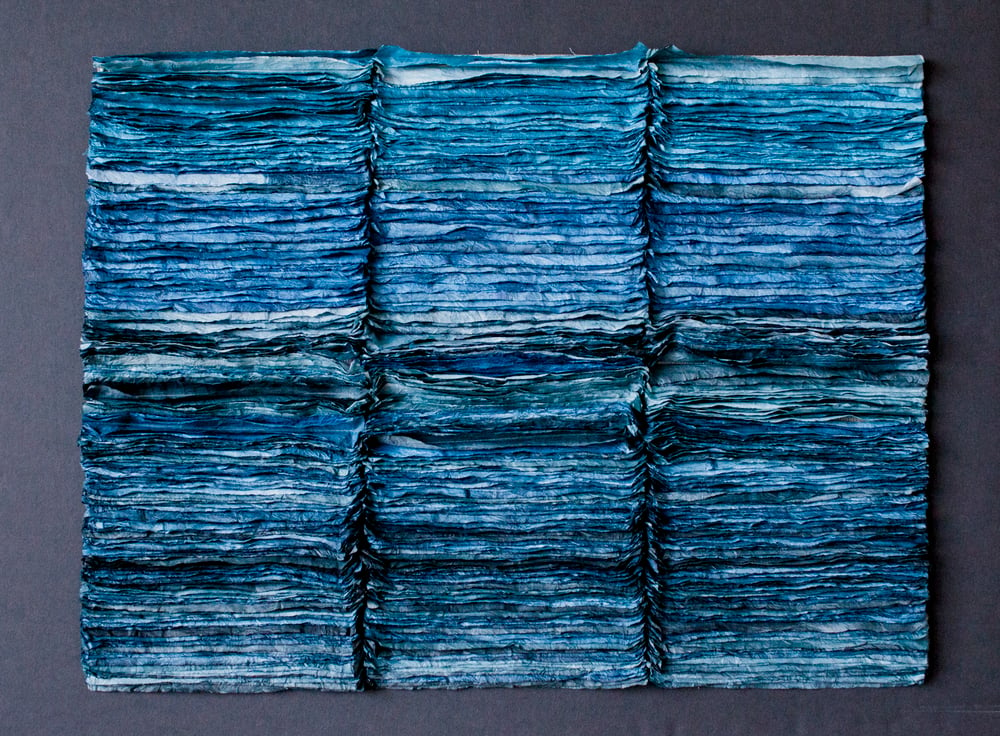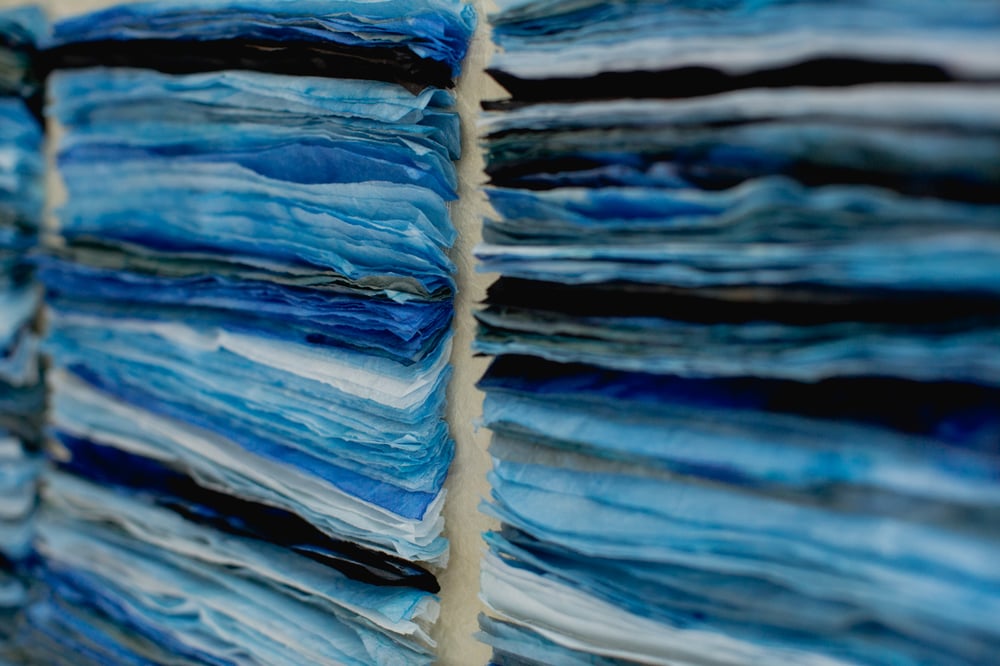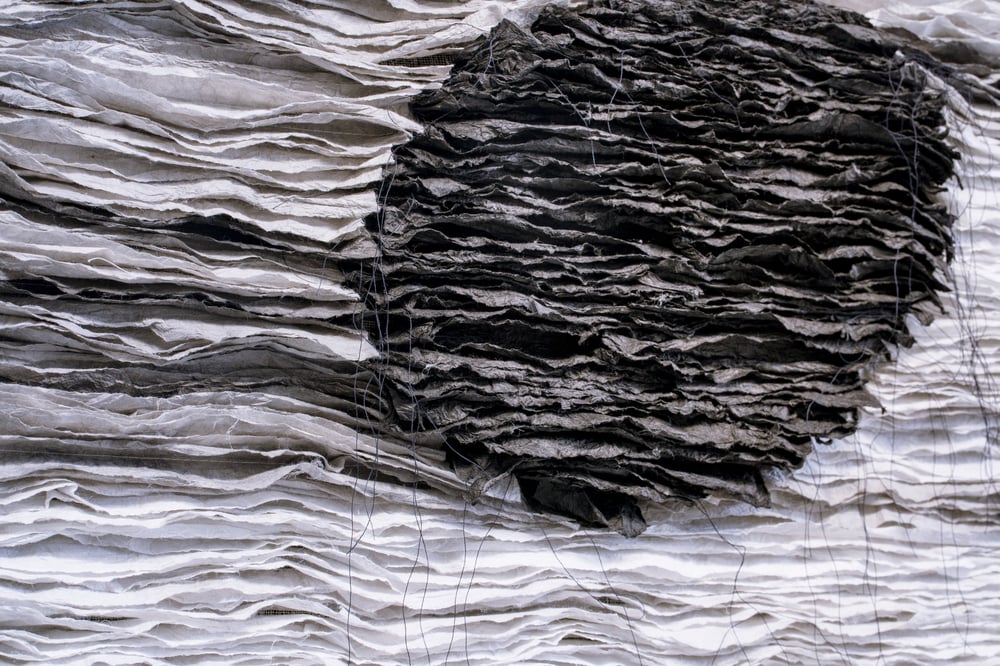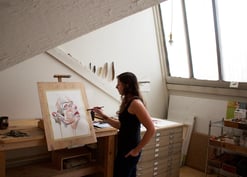For TurningArtist Yoonshin Park, there is a certain intrigue in the making of handmade paper. The patterns of the fiber and the thick, tactile texture create boundless possibilities for how she uses it as a medium. She believes that the fragile layers of paper capture the traces of accumulated time. By manipulating this material to show its delicate features and splintered composition, Yoonshin strives to communicate the beauty of being fragile, fragmented, and vulnerable.
Can you tell us about your process?
I've always been interested in creating environments where viewers can think about different qualities and get a sense of time and place. The idea that we each have different experiences during a certain time and in a certain space is the main inspiration behind many of my projects. The majority of my work focuses on dimensional and tactile creations. My process involves incorporating techniques often found in bookbinding and paper-making. In the studio, you’ll find me creating stacked forms of paper or adapting raw fiber and pulp in unconventional ways in order to produce new works.  Can you tell us about your journey to becoming a professional artist?
Can you tell us about your journey to becoming a professional artist?
I went to a graduate program with a background in literature. My research on the materials for one of my installations, "Finding Space", led me to further pursue the field of Book and Paper Arts. My exhibition career took off during graduate school with that particular project, and I've been continuing the studio practice ever since.
When you are looking for inspiration, what resources do you turn to?
I always seek varying perspectives in general: how and what issues or concepts are explained, solved, or delivered in various contexts. When struggling with too many starting directions, I like to check out non-art periodic publications for a fresh view. For example, I like to watch cooking shows where complicated creations often begin with simple chopping and paring of ingredients are created. These shows also provide me with great visual inspiration.
Walk us through a typical day in your studio. What is your routine? Has it changed with COVID-19?
A day in my studio changes depending on the project schedule (deadlines) or planned exhibitions. Usually, I start my studio work by cleaning: sweeping floors, or reorganizing the workstation because fibers and papers can easily get contaminated. Doing simple physical activities with repetitive motions can also switch on my work mode. A major change in my routine with Covid-19 would be working more hours at home rather than spending long hours in the studio. The isolated time and limitations that came with the pandemic allowed me to revisit some of my old and current projects with a fresh mind and sparked an idea to create a series that could be done from home. Finding the right rhythm to be productive in the studio can be a challenge, what advice do you have for staying productive and focused?
Finding the right rhythm to be productive in the studio can be a challenge, what advice do you have for staying productive and focused?
Often inspiration can take you in many directions, which is better than not having enough ideas. I tend to write down the lists of ideas that pop up to revisit and evaluate later on. Having a pre-determined list of things to do during studio hours has been a good working strategy - I try not to forget to create the list before leaving the studio.
What advice do you have for combating creative block?
Whenever I feel blocked I think about the cars in a random lot parked for a long time with dusty window shields. The longer the parked state lasts, the harder it is to get the engine started.
Several years ago, I experienced a serious creative block for a surprisingly extended period. It lasted quite a while, and getting out of it was a real challenge. After that experience, I try not to turn off the engine for too long and keep the habit of keeping my hands busy, even if that means drawing one hundred circles every day. Feeding a small number of unexpected stimuli during daily studio practices, such as changing the habit of using familiar tools, usually does the trick. I think the careful observation of the current state of mind also helps.
As an artist, how do you measure success? Can you recall a specific event in your career that made you feel successful?
I honestly do not know how to measure my success. Creating timeless and well-acknowledged art, maybe? I don't think I have had that honor yet. With art critique being so subjective, I often find myself falling back on my personal goals to help gauge my progress. If I managed to complete and achieve the goals that I set for myself during the year, I consider that a completed milestone. However, there are some occasions during the process where completed projects guide me to a path where I can experience genuine reactions from the viewers. How do you see the art market changing? Where you do see yourself in this transition?
How do you see the art market changing? Where you do see yourself in this transition?
With the pandemic, the virtual platform seemed to become a new norm. It expanded the boundaries for artists to encounter new opportunities and audiences on the global level. I found that with the many changes and challenges in our daily life and the studio practice, we need an attitude that is more flexible and open to new things. Although I struggled, at first, to adapt to this new way of communication and expression, I have now found myself thinking of ways to express myself through this new medium of technology.
What advice do you have for artists who are beginning to build their careers? Have there been any habits or strategies that you have adopted that you feel have created more opportunities or visibility for your work?
My mentor once advised me to have groups of supporting people around me throughout my career. I strongly agree with the thought of being surrounded by creative people. These groups could include your artist friends, critiques, membership-based organizations, and so on. Any artist's life and studio practice can be extremely isolating and solitary, therefore, creating a network of support is always helpful.
Do you consider yourself, and all artists, to be entrepreneurs? Why or why not?
Yes, we are all entrepreneurs in our own ways. Working as a practicing artist, one has to play multiple roles: creator, promotor, bookkeeper, studio manager, and many other titles. It is usually up to us to make our creations known to the public and advocate for what we are trying to express.
Failure is an inevitable part of success in any field. Do you have advice for overcoming setbacks?
If we define "failure" in one's art career as "being rejected" from opportunities, then one has to work on building thicker skin. It's a never-ending loop of challenges and disappointment. The only way to overcome it is to be less sensitive about the outcome of the work you passionately created. Other kinds of failures that often happen in the studio while creating can sometimes be a happy accident, so you have to keep the creative mindset open. What sparked your interest in partnering with TurningArt?
What sparked your interest in partnering with TurningArt?
Having a new platform to expose my work is always thrilling. Working with TurningArt has allowed me to connect with a new audience and see the possibility of sharing my art in various workplaces in cost-efficient and time-saving ways. I look forward to my continued partnership with TurningArt.
What does having your artwork in the workplace and other commercial or public spaces mean to you?
Most of my experience in sharing my artwork has been in galleries where many viewers are experts in or well-accustomed to seeing art. In public spaces, I may reach a broader audience to share and spread my creative energy and spark conversation and thoughts in groups that may not be familiar with what I've been creating. I get excited about the idea that my work could incite a reaction from a new group of people.
To see more featured TurningArtists, return to our blog. To get Yoonshin's art in your space, set up a free consultation with an Art Advisor here!




.jpg?width=332&height=177&name=%E6%A9%983-2%20(1).jpg)

